|
The key rules to determine what is the species
name of the crab you are holding:
Asian shore crab have three teeth on each side of the
eye. Three is the fewest
number of teeth on each side of the eye
that you will find on any crab.
This crab is also one of the
smallest crabs on the New England coast.
The Chinese Mitten
crab has 4 teeth (lateral spines) and is not found on the New
England coast. If found, please collect, kill, and send that to me
or MIT Sea Grant.
European Green crabs have 5 teeth on each side of the
eye.
How many letter in the word "green"? 5.
How many teeth on
each side of the eye on a European green crab? 5.
This is a great
way to know if you find a crab with 5 teeth on each side
of the
eye it is an invasive European green crab.
The native crabs,
jonah and rock crab, both have 9 teeth and grow larger than
both
the invasive crabs. So if the crab has more than 6 teeth on
each
side of the eye the crab is native. These two crabs are very
hard to
differentiate but that is OK because they are both
native.
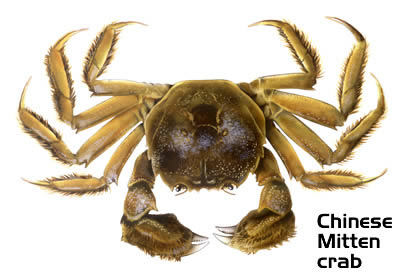
The Chinese Mitten crab has 4 teeth (lateral spines) and is not
found on the New England coast. If found, please collect and store
in ethanol. Please send a picture of your find and the location it
was collected to: InvasiveTracers@hotmail.com
Two actual pictures of this species are below. It is
one of the 100 worst invasive species!
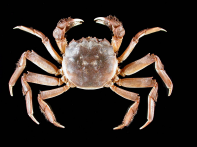 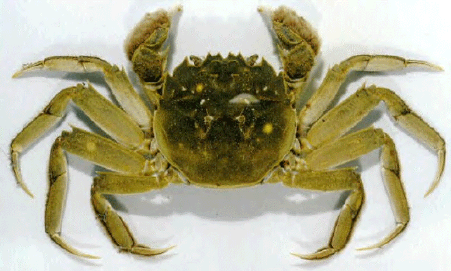
The Usual
Suspects:
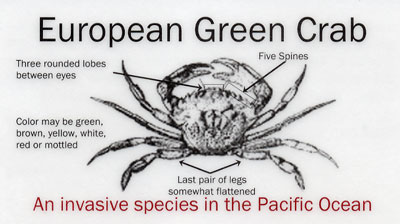 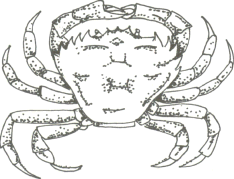 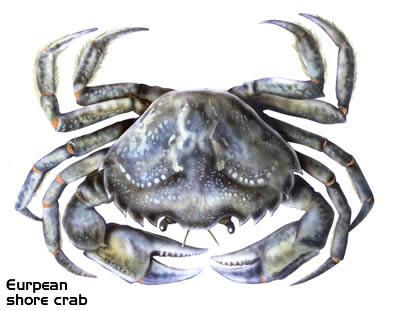
European
Green Crab (Carcinus
maenas)
On
the left, notice the 5 teeth on each side of the eye. The number of
teeth on each side of the eye is vital for proper
identification.
www.clarku.edu/.../lrkaplan/introduction.htm;
http://www.starfish.govt.nz/shared-graphics-for-download/european-shore-crab-large.jpg;
www.uaf.edu/.../papers/
2004/homer-crabs.html
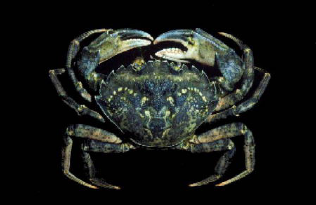
C.
maenas (European green crab)
Here
is a specimen drawn in Color. This is the green color but they
can be any color: red, brown, algae covered. Don't be deceived if
you find a red "Green Crab". It lives in sandy beaches
and lagoons of esturaries (where fresh water of a river and salt
water of the ocean mix and create brackish water) and rocky
beaches.
www.gisp.org/casestudies/european_green_crab.asp
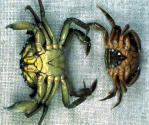 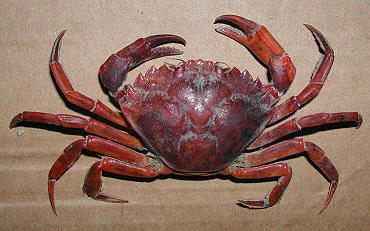
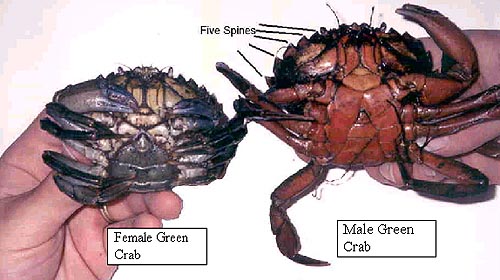
Both
sexes of what species of crab?
On
the left is a male green crab. Notice the tail flap is thin and
shaped like a light house or the Washington
monument. On the right is a female green crab. The abdomen
(tail flap) is wider and more rounded. Notice the C. maenas (green
crab) is red.
What
is the species and sex of the third crab (the one furthest to the
right)?
It
is a European green
crab! Did you get tricked? This is a great lesson.
www.seagrantnews.org/news/aliens_010213/20010... www.beachwatchers.wsu.edu/
ezidweb/grncrb01.htm
http://wdfw.wa.gov/fish/ans/greencrab.htm
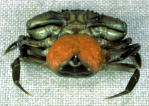
A
berried female C. maenas:
Belly
shot of a gravid (pregnant) female crab.
The
female invasive crab has her eggs under her rounded tail flap. She
can carry as many as 185,000 - 250,000 eggs in a single brood. They
may have one or two broods in a breeding season (late April to
September).
www.seagrantnews.org/news/aliens_010213/20010...
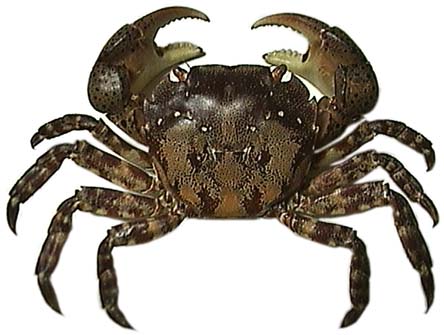
Asian
shore crab (Hemigrapsus sanguineus): This
crab is smaller than the European green crab. It have a more
squarish body (carapace) and three
teeth,
instead of five, on each side of the eye.
Their claws are larger in comparison to their small body
size. Notice the and brown and tan mottled
color.
The crab resides mainly in cobblestone and rocky
beaches. They have also been reported to be found in the chinks
of metal chains on docks and moorings.
http://www.iisgcp.org/EXOTICSP/images/Japanese_shore_crab/hiraiso.jpg
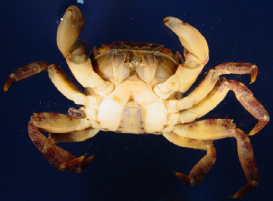
Is this a male
or female Hemigrapsus?
It is a male since the tail flap (the small
darker section of the carapace) is shaped like a light
house!
http://cars.er.usgs.gov/Nonindigenous_Species/Asian_shore_crab/asian_shore_crab.html

They
are small but are strong and must be stopped!
This species is
small with adults ranging from 35 mm (1.5 in) to 42 mm (1.65 in) in
carapace width.
http://cars.er.usgs.gov/Nonindigenous_Species/Asian_shore_crab/shorecrab2.jpg
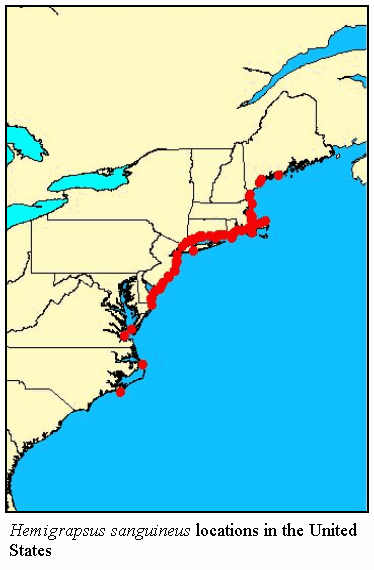
http://cars.er.usgs.gov/Nonindigenous_Species/Asian_shore_crab/asian_shore_crab.html
The Native Species:
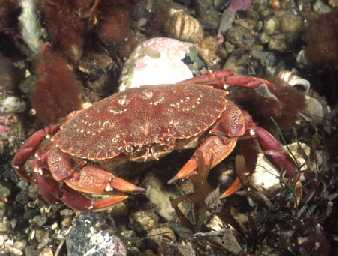
Rock Crab - Cancer irroratus less distinct 9 spines and grow
to larger sizes. These native crabs live more subtidal, so you may
not find this crab. Its numbers have been lowered due to the
thriving populations of invasive crabs, the European and Asian
shore crabs.
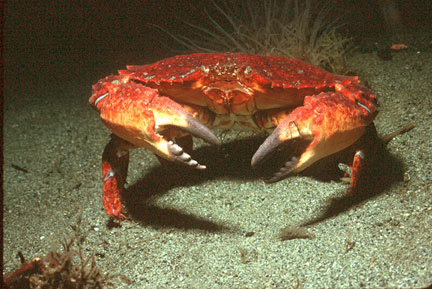
Jonah Crabs
look almost exactly identical to Rock crabs due to similar color and
possessing 9 teeth on each side of the eye. So although it is hard
to identity these 2 crab species, it is not that important since
they are both native. This is not ideal but is probably needed
since the two crabs are very similar in appearance and only vary by
behavior and one has slightly more frilly teeth.
My research
cares more about the densities of invasive and native crabs, so it
is not vital to determine if the 9 teethed crab is a jonah or rock
because we know for sure it is a native crab. This is why the best
way to identify crabs is by the number of teeth and not color.
Native crabs have 9 teeth while the invasive European green crab is
the only one you will find with 5 teeth and the Asian with 3 teeth
on each side of the eye.
www.biomescenter.com/jonahcrab_pic.htm
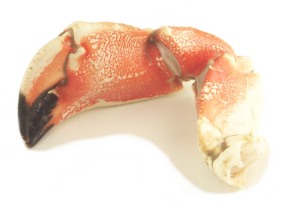
Rock Jonah have black coloration on their pincers.
www.foodsubs.com/Shelfishcrab.html
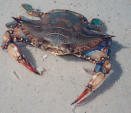
Blue Crab: Native crab that has the flattened tail of the
swimmer crab.
http://www.fisheries.vims.edu/femap/fish%20pages/blue%20crab.htm
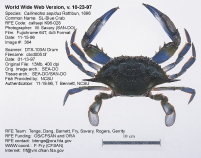
Another blue crab.
http://www.cfsan.fda.gov/~frf/cbrd405w.jpg
Best Ways to pick up crabs?
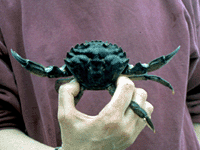
This
picture shows one of the two best ways to pick up a crab and not get
pinched. What type of crab is in the picture? How did you tell?
If
you said color, give me a better and more solid
answer!
The
color can be deceiving but in this nice picture, you can see the 5
teeth of the invasive European green crab.
http://www.seagrantnews.org/news/aliens_010213/20010213_aliens_yamada.html
The other best way is again to use two finger but on the
backside of the crab.
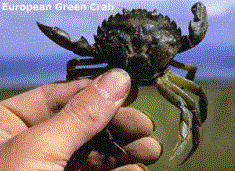
http://wdfw.wa.gov/fish/ans/greencrab.htm
•Photos
courtesy CA Dept. of Fish and Game
•Info for ID
•http://www.iisgcp.org/EXOTICSP/Chinese_Mitten_Crab.htm
Here are pictures of the first CSI Detectives!
This great group from Boston went out during the rain and collected
the first set of data on Georges' Island in
Boston, MA! Many
thanks to them, they exemplify what CSI: MISMO is all about. Rain or
shine, going to the coast and collecting important data!
A
million thanks for these great efforts. Here are the pictures,
not sunny and bright, but the data is so important!
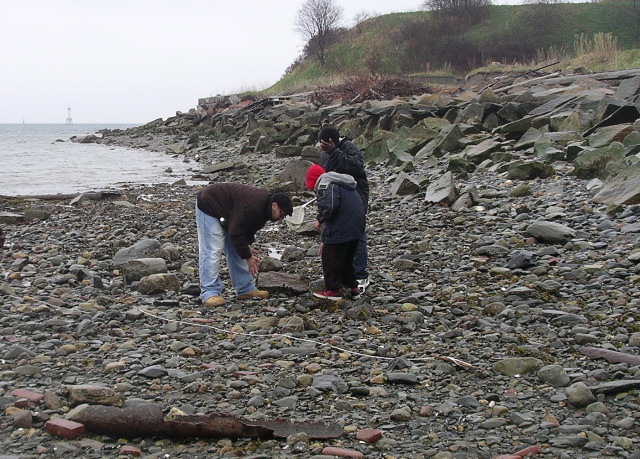 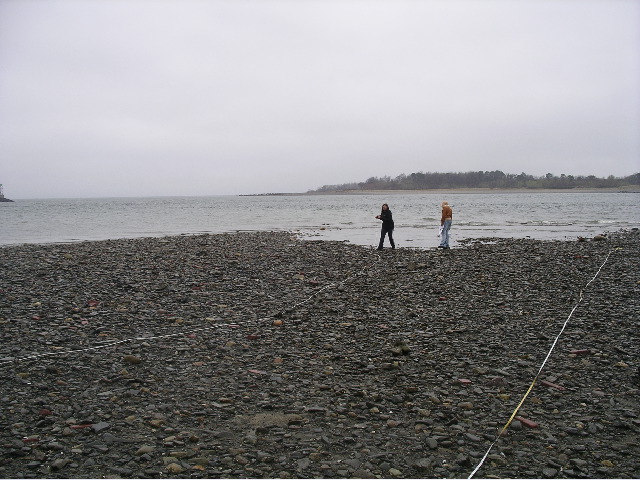
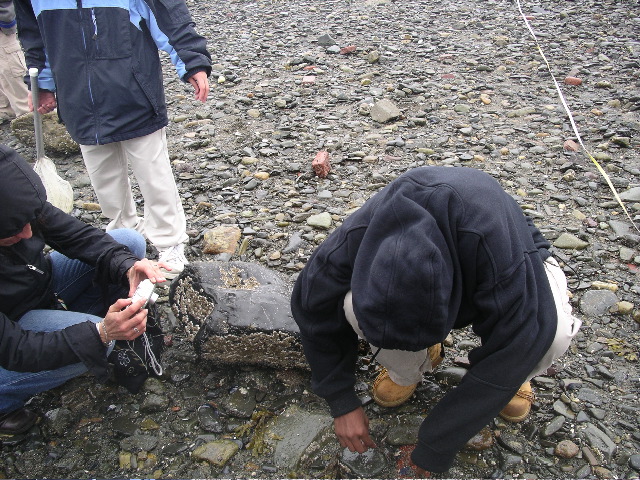 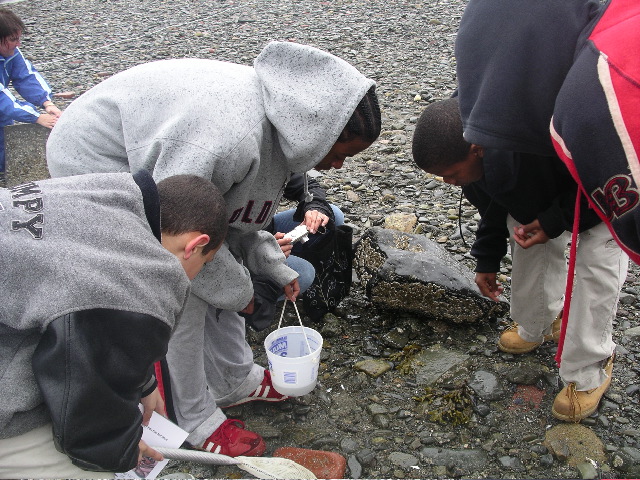
6th
Graders from the Harbor Middle School, a Boston public school,
working through Harbor Connections; in collaboration with the Boston
Harbor Islands national park area.
Crab
Carapace Quiz:
SPACE
FOR YOUR
PICTURES! | 








